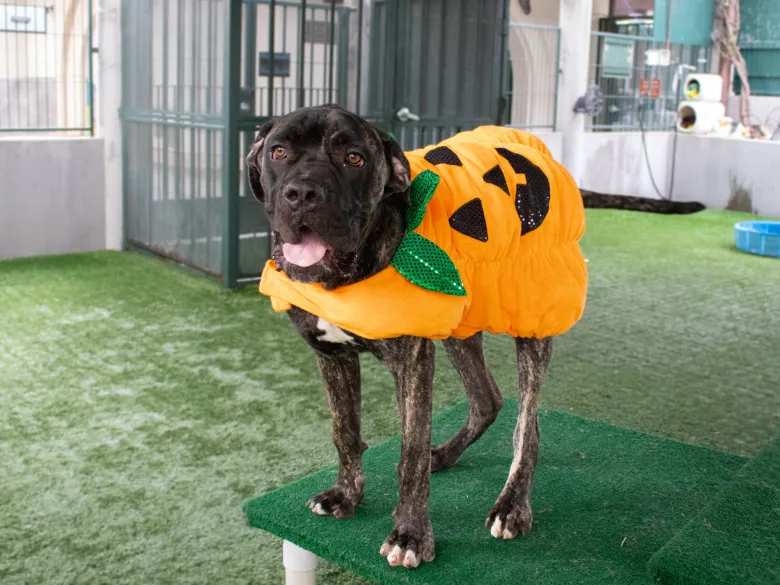Column: Halloween costumes for dogs or other pets are a treat or tricky

Meet Theo (A517515), an 11-month-old mastiff mix. This sweet and playful pup loves wearing his festive pumpkin costume! He’s a big fan of snuggles, rolling around in the grass (or anywhere else), and is always ready for a treat — hot dogs and cheese are his favorites. He’s still learning about the world, but his friendly, bouncy energy will bring a lot of joy to his forever home! Theo is available for a 10-day adoption trial, so don’t miss out on the chance to meet this boisterous boy! Learn more at pasadenahumane.org/adopt.
Halloween is creeping up fast! At Pasadena Humane, it signifies the return of our beloved and very competitive annual office decorating contest.
We’re also excited about a new activity this year, Sunday’s Barks & Boos event at the Los Angeles Arboretum. Our inaugural spring collaboration with the Arboretum – Barks & Brews – was such a success that we are doing it again, with a new twist.
This will be the second time dogs have been allowed in the gardens, with proceeds from dog admissions benefiting Pasadena Humane. Of course, this October event would not be complete without a costume contest.
Plus, there will be a special book signing with Bob Weis, former president of Walt Disney Imagineering, for his newly released novel “Ghost Dog,” with 20% of proceeds benefiting Pasadena Humane. Fittingly, one category in the costume competition will be Best Ghost Dog.
Before you bring your pet in costume, our animal training manager, Rochelle Guardado, is here to answer some commonly asked questions about dressing your pet up for Halloween.
Is it OK to dress my pet up for Halloween?
Some pets enjoy the attention and warmth they receive from wearing clothing, but it’s common for our furry companions to feel uncomfortable wearing apparel. Cats are especially sensitive to novel or unfamiliar sensations, such as wearing costumes. Unless they’re already used to wearing a vest or jacket, a Halloween costume might feel more like a trick than a treat for your pet.
What should I look for in my pet’s costume to keep them safe?
If your pet enjoys dressing up, look for a lightweight fabric that fastens with Velcro and doesn’t require going on over their head. The costume should allow for freedom of movement without hindering their gait. Avoid any attached plush items or strings that may be mistaken for a toy.
How do I get my pet used to their costume?
Don’t wait until showtime to try it on. Let your pet sniff the costume and allow your pet to hear the Velcro or snaps before placing it on them. Pair the sounds with treats. Gently drape the costume over your pet’s body so they can feel the weight of it. Keep it brief.
How can I tell if the costume is causing my pet stress?
Let your pet’s body language tell you how they feel about the new get-up. Low posture, lip licking, ears pinned back, or abnormal movements are tell-tale signs your pet is uncomfortable.
While some pets show obvious signs of distress, other pets will quietly feel trapped or shut down. These pets are less likely to protest but more likely to lash out in the presence of consecutive stressful events, such as a stranger approaching (especially if that stranger is dressed like a scary clown)!
What are some good alternatives for pets who don’t like costumes?
Your pet can join in the fun by wearing a festive collar or bandanna.
As we revel in the Halloween spirit, it’s important to consider how spooky season might affect animals
- Always keep pets safely on leash or indoors.
- Stash candy out of your pet’s reach and dispose of wrappers in secure trash bins.
- While fake spiderwebs might be great for the ghoulish vibe, they can trap and harm local wildlife.
Tickets for Sunday’s Barks & Boos are still available at arboretum.org. In addition to costumes, this dog-friendly event benefiting Pasadena Humane includes craft beer, food trucks, our Wiggle Waggle Wagon with adoptable dogs and, a doggie agility course hosted by our dog training team. I hope to see you there.
Dia DuVernet is president and CEO of Pasadena Humane.
This blog post originally appeared as a column in the Pasadena Star-News on October 25, 2024.


